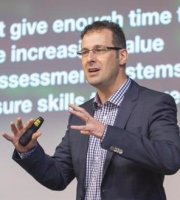A big part of the teacher’s role has always been to serve as an example to their students, of what it looks like to be educated.
When knowledge was the key to future success, a teacher was the living, breathing example of a learned person. Students could look up to their teachers and aspire to gain as much knowledge as they had. To be educated as they were.
But the world is changing profoundly and permanently and knowledge just isn’t the key to future success that it once was.
Now the keys to success are the ability to access information quickly on demand, the ability to learn concepts as needed, to see new connections between ideas, to recognise patterns. The ability to learn is now FAR more important than the knowledge itself.
So now teachers need to be living, breathing examples of dynamic learners. Students should be able to look up to their teachers and aspire to learn as effectively and prolifically as they do.
Of course if teachers are to be that kind of example to follow, they need to be visibly learning more than their students. It’s hard to do that if you are standing in front of a whiteboard, talking about the knowledge you accumulated when you were at university.
Are you learning faster than your students are? Or are you resting on the laurels of stuff you learned when you yourself were a student?
Learned or learner?
